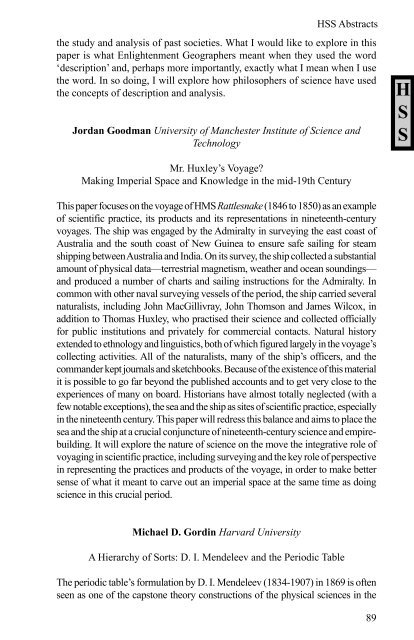2000 HSS/PSA Program 1 - History of Science Society
2000 HSS/PSA Program 1 - History of Science Society
2000 HSS/PSA Program 1 - History of Science Society
You also want an ePaper? Increase the reach of your titles
YUMPU automatically turns print PDFs into web optimized ePapers that Google loves.
<strong>HSS</strong> Abstracts<br />
the study and analysis <strong>of</strong> past societies. What I would like to explore in this<br />
paper is what Enlightenment Geographers meant when they used the word<br />
‘description’ and, perhaps more importantly, exactly what I mean when I use<br />
the word. In so doing, I will explore how philosophers <strong>of</strong> science have used<br />
the concepts <strong>of</strong> description and analysis.<br />
Jordan Goodman University <strong>of</strong> Manchester Institute <strong>of</strong> <strong>Science</strong> and<br />
Technology<br />
H<br />
S<br />
S<br />
Mr. Huxley’s Voyage?<br />
Making Imperial Space and Knowledge in the mid-19th Century<br />
This paper focuses on the voyage <strong>of</strong> HMS Rattlesnake (1846 to 1850) as an example<br />
<strong>of</strong> scientific practice, its products and its representations in nineteenth-century<br />
voyages. The ship was engaged by the Admiralty in surveying the east coast <strong>of</strong><br />
Australia and the south coast <strong>of</strong> New Guinea to ensure safe sailing for steam<br />
shipping between Australia and India. On its survey, the ship collected a substantial<br />
amount <strong>of</strong> physical data—terrestrial magnetism, weather and ocean soundings—<br />
and produced a number <strong>of</strong> charts and sailing instructions for the Admiralty. In<br />
common with other naval surveying vessels <strong>of</strong> the period, the ship carried several<br />
naturalists, including John MacGillivray, John Thomson and James Wilcox, in<br />
addition to Thomas Huxley, who practised their science and collected <strong>of</strong>ficially<br />
for public institutions and privately for commercial contacts. Natural history<br />
extended to ethnology and linguistics, both <strong>of</strong> which figured largely in the voyage’s<br />
collecting activities. All <strong>of</strong> the naturalists, many <strong>of</strong> the ship’s <strong>of</strong>ficers, and the<br />
commander kept journals and sketchbooks. Because <strong>of</strong> the existence <strong>of</strong> this material<br />
it is possible to go far beyond the published accounts and to get very close to the<br />
experiences <strong>of</strong> many on board. Historians have almost totally neglected (with a<br />
few notable exceptions), the sea and the ship as sites <strong>of</strong> scientific practice, especially<br />
in the nineteenth century. This paper will redress this balance and aims to place the<br />
sea and the ship at a crucial conjuncture <strong>of</strong> nineteenth-century science and empirebuilding.<br />
It will explore the nature <strong>of</strong> science on the move the integrative role <strong>of</strong><br />
voyaging in scientific practice, including surveying and the key role <strong>of</strong> perspective<br />
in representing the practices and products <strong>of</strong> the voyage, in order to make better<br />
sense <strong>of</strong> what it meant to carve out an imperial space at the same time as doing<br />
science in this crucial period.<br />
Michael␣ D. Gordin Harvard University<br />
A Hierarchy <strong>of</strong> Sorts: D. I. Mendeleev and the Periodic Table<br />
The periodic table’s formulation by D. I. Mendeleev (1834-1907) in 1869 is <strong>of</strong>ten<br />
seen as one <strong>of</strong> the capstone theory constructions <strong>of</strong> the physical sciences in the<br />
89
















